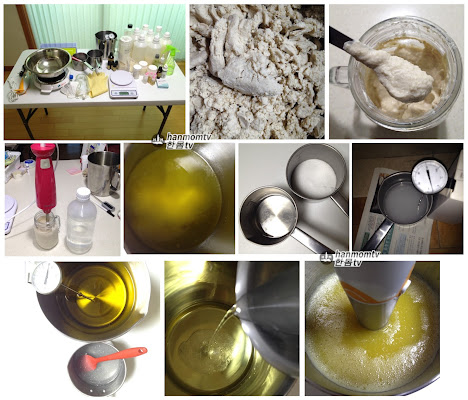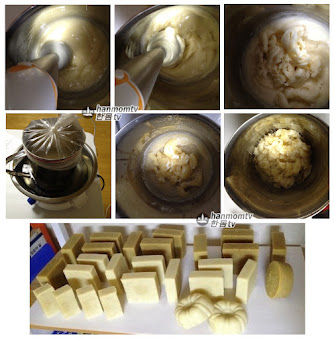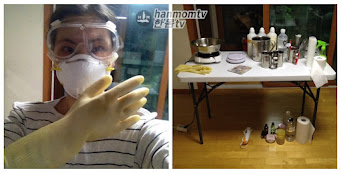How to make soap
I have been making and using natural soaps at home for several years to replace the petrochemical surfactants in most commercial soaps and detergents. I hope this post of my early experiences with some photos below will be helpful to those who want to make use of natural soap.
February 17, 2016
Hot Process Soap (CP Soap)
[Ingredients]
Oil = Palm 150g + Coconut 90g + Castor 60g = 300g
Pure soap = oil 300g + lye (caustic soda) 46g = 346g
Solvent = 346*9/11 = 283g
Sugar = (346+283)*0.08 = 50g
lye + purified water = 99g
Glycerin (61g)
ethanol (104g)
Remaining purified water (sugar and other dissolved)
= 283-264 = 19 g
1-2. Palm (150g), coconut (90g), castor (60g), caustic soda (46g), purified water (118g), glycerin (61g), absolute ethanol (104g), essential oil (Tea Tree, Bergamot, Lavender, Eucalyptus)
2. Disinfect container - Improve base oil (300g) - Improve caustic soda (46g) and purified water (99g) - Heat base oil - Set both sides to the same temperature by 5-60 degrees, pour caustic soda into purified water and use a hand blender Mix.
3. Thick trace progress in a generous container.
4. Fully sealed with plastic and bathed in a bath for about 30 minutes (maintaining the temperature at 70-80 degrees)
5. Mix the opaque jelly soap solution well, add glycerin (61g) and ethanol (104g), and mix with a hand blender - Mix well until it becomes completely liquid.
6. Continue blending until hard, then seal with plastic and bath for 30 minutes. After boiling, add sugar solution and make a liquid while boiling again and add additives.
[Review]
While learning the caustic water soap HP technique in a natural cosmetics class, I recalled the memory of hand-blending the mixture until it became thick enough that it could no longer be blended, so I boldly continued using the blender. In fact, when I experimented in the class, I added glycerin and ethanol and blended for about 1 minute until it became liquid, and it seems that I did just that much and then proceeded with heating in a hot water bath for 30 minutes... Shouldn't have continued blending what was enough for 1 minute. And I couldn't remember the next step, so I heated it in a hot water bath to liquefy it, and then mixed it again with a blender, but it seemed to have failed to make the first transparent soap I intended. Instead, it turned out to be a very thick, heavy, viscous, clay-like, but fully saponified dough.
On the other hand, the mixing process by adding additives seems to be much simpler - since the dough comes out thick, it seems less brittle even when liquids such as makgeolli liquid are added. A few days later, I did the PH test with a phenolphthalein solution and litmus test paper, and it easily passed.
March 10, 2016
Cold Process Soap & Hot Process Soap
1. Prepare and set ingredients
2. Prepare makgeolliji lees
3. Mix and pulverize lees with purified water
4. Prepare Oil (Grape Seed Oil, Olive Oil, Castor, Coconut, Palm, Shea Butter)
5. Prepare caustic soda and purified water
6. Pour caustic soda into purified water
7. Adjust oil temperature and caustic soda solution temperature (60-70 degrees)
8. Pour caustic soda into the oil
9. Mix them with Blender

So far is how to make CP soap, which is mixed at a relatively low temperature to create a low trace state and poured into a mold for aging.
HP soap is made when the same mixture is traced more, and heated in boiling water, for more than 1 hour at high temperature.
For CP soap, if the caustic soda is not completely saponified, skin irritation can be great, so a 'discount' can be done by reducing the amount of caustic soda by 5% or a 'super fat' that increases the amount of oil be applied. . So caustic soda, saponification, and rancidity of the remaining oil can be issues. On the other hand, HP soap is heated at a high temperature to completely react the caustic soda with the oil, thereby reducing the above concerns and shortening the aging period. These HP soaps are a little more complicated to make.

After tracing and sealing, heat the mixture in boiling water twice and put in alcohol and sugar solution in between.

The above recipes and records are posted to share my very personal experience and experiment.
Please be reminded that the user is solely responsible for any skin irritation and problems that may occur when making cosmetics according to this recipe.




